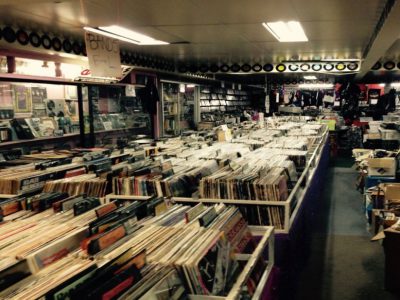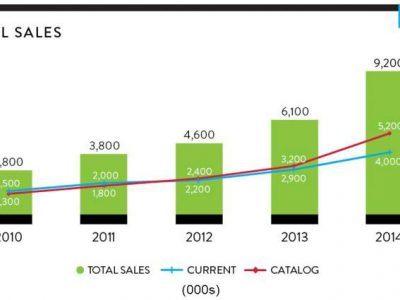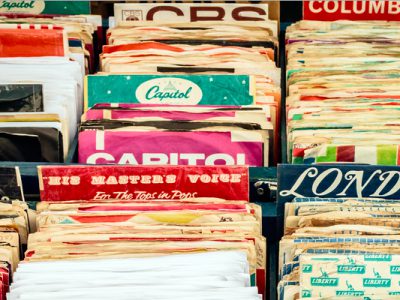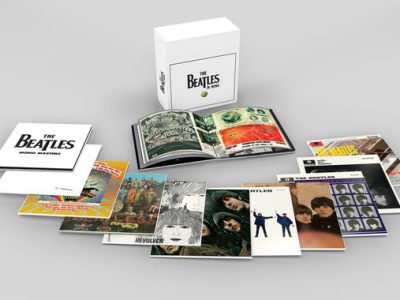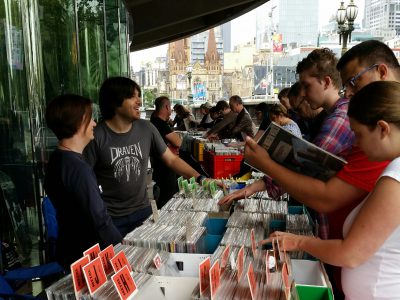The resurgence of vinyl has everybody talking, and listening.
Maybe you’ve thumbed through a trend piece in The New York Times, crediting analog-loving millennials as the impetus for the revival. Or, you’ve read in Billboard or on Pitchfork about the trouble that comes with manufacturing vinyl. Perhaps you passed through a Barnes & Noble store over the holidays to find LPs of current releases from Adele and Taylor Swift dominating displays in the music section. Or, could it be that you’re an audiophile who has more than 1,000 records stored meticulously in your apartment—and can’t resist rolling your eyes when yet another magazine piece proclaims that the ancient vinyl record has been resurrected in a digital age and might just resurrect the recording industry along with it.
There are also those like President Obama, and so many others, who got a turntable as a gift (a record player was the top selling home-audio product on Amazon this past holiday season) and are just now building up your LP collection, four decades after the medium was overtaken by the compact disc and declared dead—before the MP3 came along and, in turn, virtually did in the CD. “Even the leader of the free world has rediscovered vinyl,” notes John Sykes, president of entertainment enterprises at iHeartMedia, who gifted Obama—who gives a keynote address on the first day of South by Southwest in Austin, Texas—all of the Beatles’ remastered albums. “He’s a music fanatic, and I always bring him music when I see him. We have this joke: ‘You don’t get out and visit a record store when you’re in the White House.'”
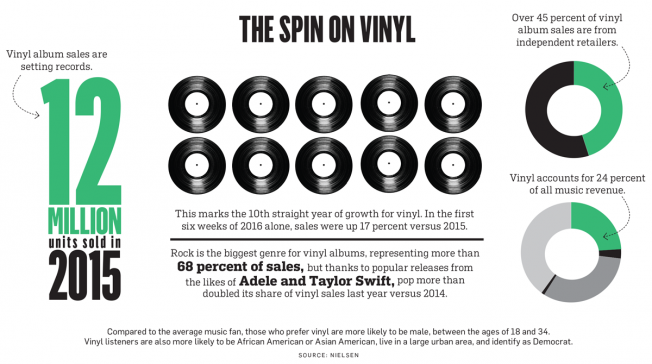
Vinyl sales have steadily grown over the last decade, with 12 million units moved in 2015, according to Nielsen data. In the first six weeks of this year, sales are up 17 percent compared to the same period last year. Those figures define what Marshal Cohen, chief industry analyst at NPD Group, refers to as a “consumer-born trend,” one that’s impacting record labels, record-pressing plants, mom-and-pop record stores, electronics brands, retailers like Barnes & Noble, Amazon and Urban Outfitters—and, of course, marketers who are capitalizing on the trend.
Crosley, the electronics company known for its low-cost, vintage-inspired turntables, last year essentially doubled what sales were in 2008, with 1 million turntables sold in 2015. In 2007, Crosley began its relationship with Urban Outfitters, the millennial-focused clothing chain known for its kitschy tchotchkes and home goods. That relationship has helped redefine Crosley, says Jason Menard, its director of marketing. “Our consumers have sort of dictated that we’re a lifestyle brand more than an electronics brand now,” he says. “For us, at least, Urban Outfitters had a huge role in turning Crosley into a lifestyle brand.”
It’s fitting, then, that Crosley will host a SXSW activation at Urban Outfitters’ concept store, called 24 Twenty, March 16-19. There, the brand will set up a vinyl-cutting demo where visitors can step into a booth, record a song, and see it pressed onto seven-inch vinyl. That is just one example of how Crosley is now capitalizing on the vinyl wave. This spring, as part of its push into experiential marketing, Crosley will launch a mobile record store, dubbed the Crosley Cruiser. Housed in a revamped, 20-foot box truck that will spend most of the year in Louisville, Ky., the promotional vehicle will travel across the U.S. to music festivals, pop-up shops, flea markets, local record stores and more to promote vinyl and the Crosley brand and make shopping for a record a one-of-a-kind experience.

In a sense, that is the very point of all this. Vinyl has made its surprising comeback largely because millennials want the kinds of experiences vinyl provides. “Most of my music experience was through [file-sharing applications] Napster, Kazaa, LimeWire, and then iTunes and the whole digital music revolution,” explains 28-year-old Matt Fiedler, CEO and co-founder of Vinyl Me, Please, a record of the month club. “So I think it’s our generation coming back to this idea of analog. The more digitized, more technologically advanced the world becomes, the more people crave this kind of physical, tactile experience of something.” (Vinyl is not alone, with old-fashioned products of all sorts—from cassettes and the Polaroid camera to Olivetti typewriters and Field Notes—enjoying a surge in popularity, especially among the young.)
At Vinyl Me, Please, which launched in January 2013 and by the end of last year had amassed nearly 15,000 members, Fiedler and his partners market to their members a “full sensory experience” for vinyl enthusiasts. What does that entail? Well, not only do they send out a vinyl pressing exclusive to the club’s members each month, but that mailing comes with special artwork and a cocktail recipe designed to go with the album. The club also seeks to foster community with a forum, via vinylmeplease.com, enabling a shared experience around an album.
Vinyl Me, Please isn’t alone. There’s also Vynl, Record Friends, Feedbands, That Special Record, Insound Record Club and more, as a whole band of record of the month clubs have sprung up because of the vinyl boom. It makes sense. The vinyl fan is a high-value consumer willing to spend in excess of $30 for a newly pressed album. “It’s obviously a buyer who is extremely important and doesn’t mind paying for the high price of vinyl,” notes David Bakula, svp of industry insights at Nielsen. “The audio quality is high, but they’re not just paying for that. It’s also the packaging, the collectibility, being able to display it and touch it and feel it. That’s very important for vinyl buyers. It’s a bit of a lifestyle play.”
Carrie Colliton, co-founder and director of marketing at Record Store Day, an annual celebration of the 1,400 independent record stores in the U.S. and abroad, agreed. “A record collection or a book collection, it can be a way of marking individuality by what you own,” she says.
Record Store Day kicked off on April 19, 2008, just as vinyl resurrection was beginning, and since its inception, it has become so popular that major U.S. cities including New York, Los Angeles, Las Vegas and others have declared it an official holiday. On April 18 last year, it got major social pickup, with 79,000 tweets mentioning Record Store Day and 47,000 tweets mentioning vinyl, according to Amobee Brand Intelligence. This year, Record Store Day will take place on April 16, with Metallica serving as its ambassador.
“Music is a really good bonding point for people,” says Colliton. “You can have a group experience with a record that you can’t have with earbuds in your ears. We’re all humans—we don’t want to be connected to machines all the time.”
As much as Record Store Day serves as a cultural touchstone, it is also about getting consumers to buy something, of course. “We market the idea of owning your own music and not streaming it,” says Colliton.
Figuring out how to create a differentiated product for consumers in a sea of streaming music platforms like Spotify and Apple Music or iTunes has been a point of concentration for everyone associated with vinyl, even labels like Interscope Records, which has built its vinyl marketing efforts aggressively over the last two years, according to Gary Kelly, head of digital and revenue at Interscope. “Streaming and downloads are almost like a commodity to a degree, where everything is the same,” says Kelly. “People are searching for that premium experience where they can show they are a superfan, and they can have that artwork sitting in their record collection or dorm room. We’re in the digital age, but here we are going back to analog in some respects.”
“A mind that is stretched by a new experience can never go back to its old dimensions.”

Cascade Record Pressing, Portland, Ore.
It wasn’t until Interscope saw major success with the 2012 release of Lana Del Rey’s album Born to Die—which spawned 118,000 vinyl units, representing 9 percent of overall sales, many of them sold through Urban Outfitters—that Interscope realized the power of the vinyl trend, according to Kelly. “Now vinyl can be 10, even 15 percent of your business on a particular artist,” he points out, noting that the label’s marketing efforts around vinyl are on an album-by-album basis. “It’s really become a fundamental part of how we do business.”
For the release of Del Rey’s most recent album, Honeymoon, the label again partnered with Urban Outfitters, giving fans a vinyl-listening party which generated social buzz for the brand. Still, even as Interscope looks at vinyl more seriously, working to make sure those artists who likely would do well on the medium are available on the medium, “the industry hasn’t really promoted vinyl,” says Kelly. “There’s been natural growth from younger consumers driving the resurgence.”
That it was natural is no doubt a big reason the vinyl renaissance has had such legs. “If this was marketed to millennials, they wouldn’t bite,” says NPD Group’s Cohen. “If you try and force it on a new generation, they’re not buying it. They’re buying it if they feel like they discovered it, so you almost have to let it come to you.”

Cohen observes that vinyl has again become commercialized enough that marketers can, well, market it. Maybe that’s why we are also seeing a sort of mini-revival of the cassette, another outdated medium that can now be found at Urban Outfitters and other retailers. Experts agree that cassettes won’t have the same impact as vinyl, though. “Absolutely not,” insists Nielsen’s Bakula. “It’s clearly just a collectible. People don’t really have cassette players anymore.” (Josh Friedlander, svp of strategic data analysis at the Recording Industry Association of America, seconds that. “Revenues from cassettes are not making much of a dent in the overall pie, but it’s fair to say there are certainly some titles on cassettes that have sold well,” he says.)
Meanwhile, vinyl is popping up more in more in advertising and entertainment. When Sonos debuted a marketing campaign last fall featuring the artist St. Vincent, the electronics brand showcased vinyl along with digital to persuade consumers to buy its speakers. A powerful PSA by the agency La Chose for the French road-safety organization Association Victimes et Citoyens used a single shot of a vinyl record player to cleverly communicate what could happen when you drink and drive.
HBO’s new series Vinyl, from Mick Jagger and Martin Scorsese, certainly keeps the medium front and center. And the audiobook of comedian Amy Poehler’s Yes Please got the vinyl treatment. “If you have a record playing on American Horror Story with Lady Gaga talking about it … stuff like that you see in the mainstream, that’s going to be good for any business,” says Ma Nerriza Dela Cerna, project manager at Erika Records, which is known for its specialty vinyl products.
There’s also the appeal of the old-fashioned album cover, which was diminished with the advent of the CD—and even the design of the LP itself, with some albums splashed with colors and images. To see that design has helped propel the medium, one need look no further than the Instagram account of Stefan Sagmeister, co-founder of design shop Sagmeister & Walsh. The designer posts album art from his record collection every day, sharing with his 59,200 followers a lost but resurgent art form.
While the number of record pressing plants has been growing rapidly, the particulars of producing vinyl are anything but timely, and sometimes artists wait months for orders to be fulfilled. “The demand for vinyl is so high that the first day we opened, people were calling us interested in running projects,” says Steve Lanning, CFO of Cascade Record Pressing in Portland, Ore., which opened last July. “There’s an inherent demand for this stuff right now and we’re filling a great need.”
Adds Dela Cerna of Erika Records: “There’s enough work right now that all of the vinyl plants are busy. Obtaining the music you want is extremely convenient right now, and vinyl is a bit of a reaction to that.” She notes that many of Erika Records’ recording clients have the plant include a free digital download card with each vinyl copy. “We don’t see it as the digital world versus the analog world—we see the two working well together to keep music alive,” she says.
That digital and analog work in harmony is key.
Over the last two years, iHeartRadio has created four stations dedicated to vinyl, with 260 million listeners tuning in every month. Vinyl “will never take over again as the mainstream platform,” says iHeartMedia’s Sykes. “But it might just find its place as an alternative for people who both want high quality and want to experience music on the format it was originally created on.”


